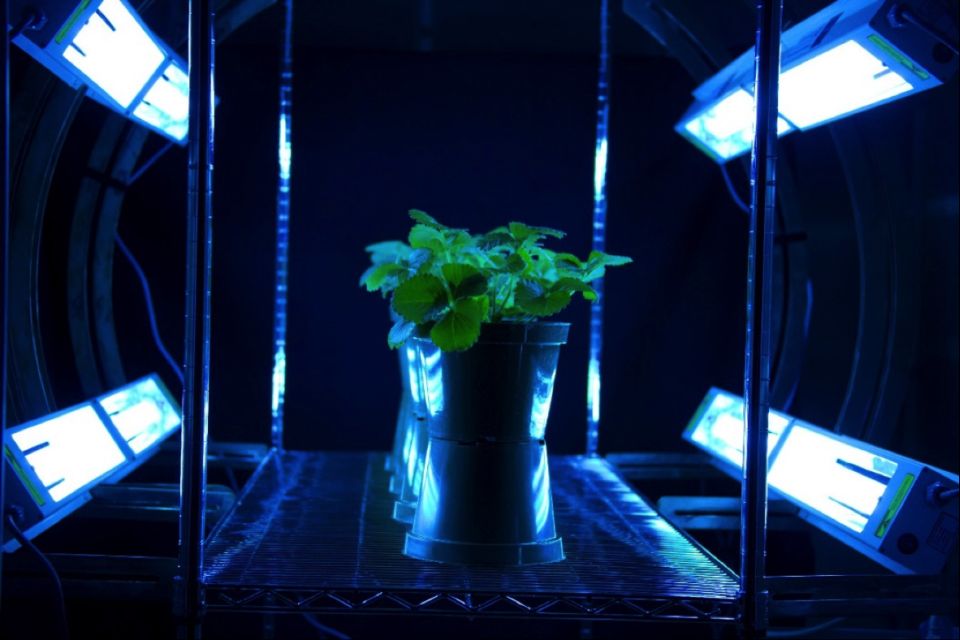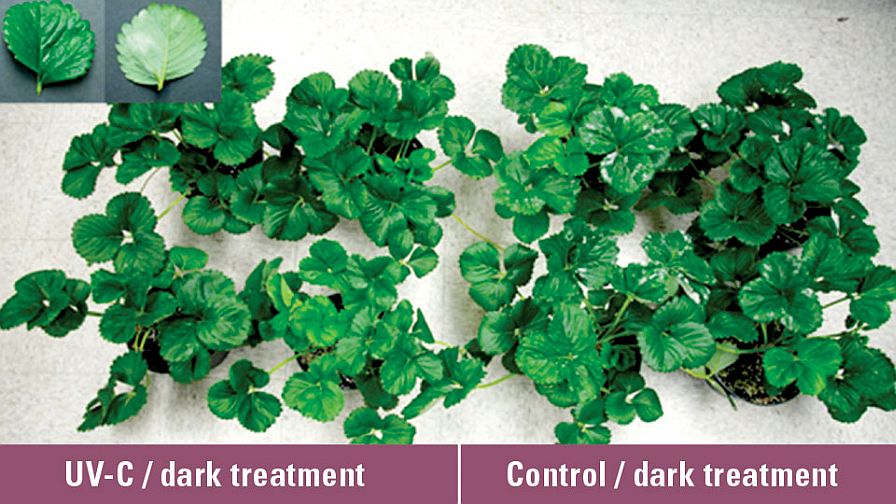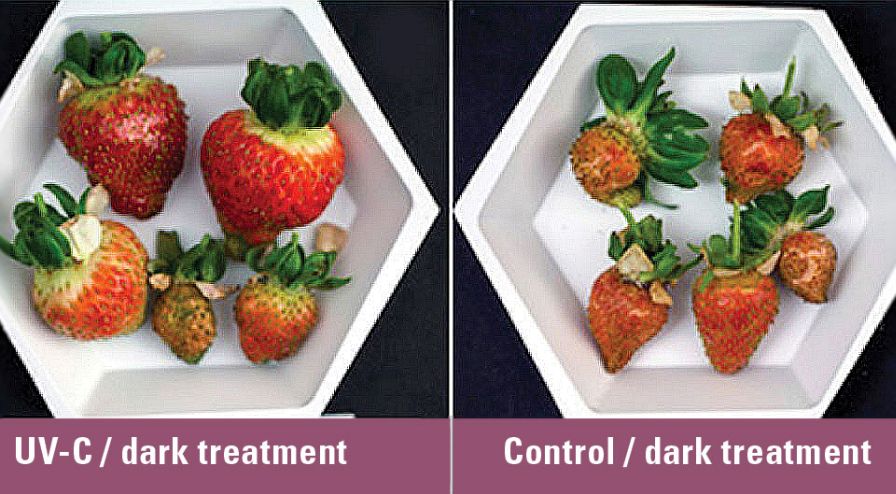How UV-C Irradiation Can Help Save Strawberries

USDA prototype of UV-C irradiation apparatus for night irradiation of strawberry plants in table-top indoor production. (Photo: USDA)
As berry consumption continues to increase, strawberry producers feel the pressure to deliver first-rate fruit. This can be especially tricky when many non-chemical disease control options have proved ineffective against the strawberry’s biggest threats: Botrytis cinerea (gray mold), Colletotrichum acutatum (black spot), and Podosphaera aphanis (powdery mildew).
At USDA’s Agricultural Research Service (ARS), however, a pesticide-free solution is beginning to emerge. New research suggests ultraviolet C (UV-C) irradiation will control plant pathogens without harming the plant pollen production or fruit set. This is exciting news for growers whose integrated pest management solutions have largely proved ineffective.

Effect of UV-C/dark treatment (60 seconds irradiation followed by four-hour dark period, once per week) on powdery mildew development on ‘Monterey’ strawberry plants three weeks after the initiation of treatment. In the upper left corner inset, one of the three leaflets of a strawberry leaf treated with UV-C/dark showing no signs of powdery mildew on the upper surface (adaxial) and signs on the lower surface (abaxial). (Photos: USDA)
Meeting Market Demands
“The idea of using UV-C to control fungal diseases of strawberry fruit came from a conversation with [USDA-ARS lead scientist and research horticulturist] Dr. Fumiomi Takeda in late 2010 when he expressed concerns about limitations to the use of fungicides and needs for alternative control methods,” explains Dr. Wojciech Janisiewicz, a research plant pathologist at the ARS’s Appalachian Fruit Research Station in Kearneysville, WV.
“In addition to the development of resistance to fungicides in major pathogens of strawberries,” he continues, “the use of fungicides in a fast-growing protective culture such as high tunnels is limited or prohibited, and a rapidly growing organic market demands fruit free of synthetic pesticide residues.”
UV-C irradiation works by damaging microorganisms’ DNA, eventually killing them. Unfortunately, the process isn’t as simple as blasting the plants with UV-C irradiation and calling it a day. Janisiewicz says the microorganisms have a special light-activated mechanism that allows them to repair the damaged DNA. To disable the ability to heal themselves, the microbes on the strawberry plant must endure a two-to-four hour dark period after the UV-C exposure.
Effective Control
Several USDA-ARS-led experiments proved this treatment combo was effective against gray mold, black spot, and powdery mildew [see figures]. The research team was excited about the results, but they began to question whether the strawberry plants experienced any negative effects from the treatments. How would the process impact pollen viability, fruit set and other important plant characteristics? The team began a new series of experiments.
“We showed that pollen germination, tube growth in vitro and germination on the stigma and growth through the style to the ovary was not affected by the UV-C/dark treatment,” says Janisiewicz.

Reduction of powdery mildew damage to strawberries by UV-C/dark treatment. Note larger fruit size, better coloring and luster, and lack of cracking on fruit harvested from plants with UV-C/dark treatment. (Photo: USDA)
“Flowers pollinated with UV-C/dark treated pollen produced fruit not distinguishable from those pollinated with untreated pollen,” he continues. “There were no signs of any toxicity to leaves on plants with UV-C/dark treatment, as typically excessive UV radiation cause leaves to turn brown. We even observed some increase in yield on UV-C/dark treated fruit, and experiments are in progress to confirm this.”
The team was also able to prove that postharvest irradiation and dark treatment could be effective against pathogens on fruit that was cut or scratched during harvest or storage. Armed with this information, the researchers at USDA-ARS set out to bring the technology to growers.
“In collaboration with Dr. Amy Tabb and Scott Wolford from our engineering unit, we developed a self-propelled, totally automated prototype machine for night-time UV-C irradiation of strawberry plants growing in high tunnel production systems,” says Janisiewicz.
The prototype can straddle over four raised beds in a high tunnel, and it has reflective surfaces on the sides. By adding reflective mulch to the raised beds between the strawberry plants, the device can deliver UV-C rays to the underside of the plant leaves to prevent powdery mildew from forming there. According to Janisiewicz, the apparatus irradiates the strawberries for up to 60 seconds twice per week. This is done at night to ensure a proper dark period following the treatment.

Fully automated prototype USDA UV-C irradiation machine for night irradiation of strawberry plants in high tunnel production. It can straddle over four raised beds. (Photo: USDA)
Greenhouse Production
For strawberries grown on tabletops in the greenhouse and other indoor growing systems, the team sought a different solution.
“We developed a multi-directional UV-C treatment apparatus that will eventually be mounted on already existing transportation lines used for sprayers and harvesting aids,” Janisiewicz says, explaining that this led to the creation of PhylloLux technology, a combination of UV-C/dark treatment and beneficial microbes isolated from the fruits that efficiently colonize the strawberry plant surfaces. “The application of the beneficial microorganisms fills in the microbiological vacuum created after UV-C/dark treatment sterilization, and at the same time, provides an additional measure to control the diseases.”
This prototype is being used in pilot tests of table-top grown strawberries in commercial greenhouses and high tunnels. The studies have certainly proved promising, but there’s still more to learn about this novel treatment option.
Project’s Next Steps
Dr. Janisiewicz says the present and upcoming research will focus on “developing microbiome-based approaches and molecular tools to assure the microbiological safety of the treatment,” using a “sensory panel to evaluate the color, firmness, juiciness, sourness, sweetness and flavor” of treated strawberries, and the treatment’s effect on strawberry plants’ induced resistance to diseases.
There is also some evidence that the UV-C/dark treatment can control mites and insects, but this research is in its initial phase.
While growers can’t integrate UV-C irradiation into their crop cycles just yet, it appears help is on the horizon. After years of failed natural solutions and crop loss, a viable prototype is enough to make anyone want to celebrate with fresh strawberries.










